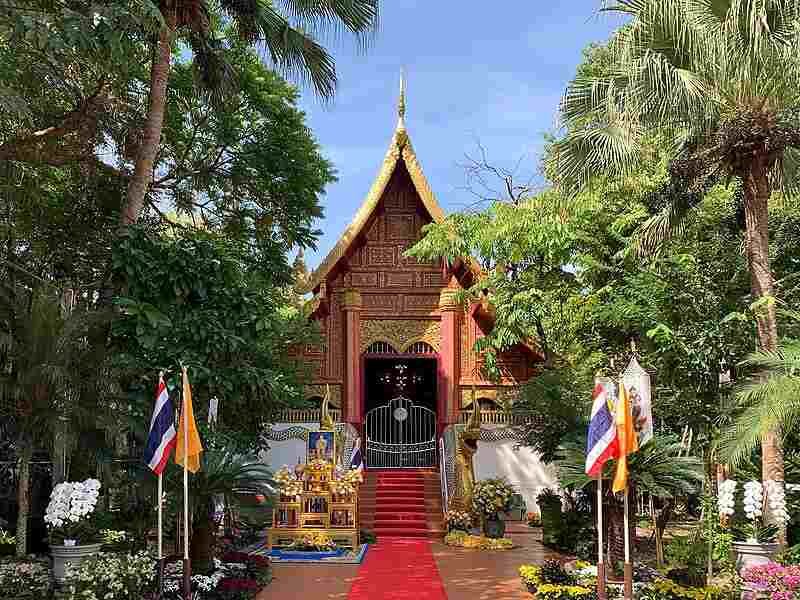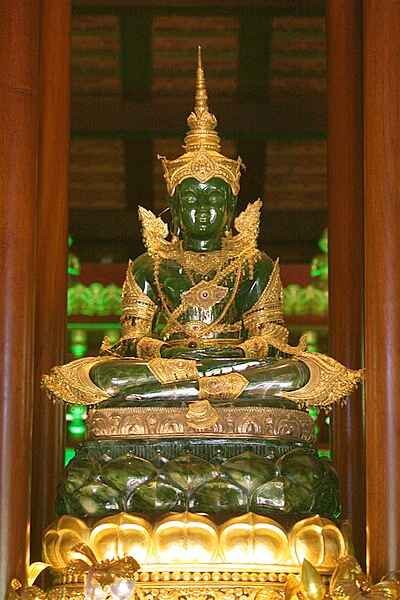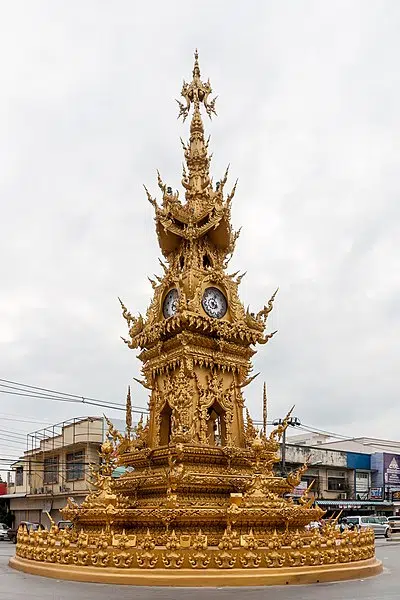Wat Phra Kaew Chiang Rai is a historically significant temple in the heart of Chiang Rai Province, Thailand. Known for its rich history and cultural importance, it is a must-visit destination for those exploring the spiritual and historical landscapes of Thailand.
Wat Phra Kaew Chiang Rai, also known as the Temple of the Emerald Buddha, Unlike its more famous counterpart in Bangkok, this temple boasts unique architectural features and a serene. The environment draws in visitors and residents equally.
This post delves into the fascinating history, architectural beauty, and cultural significance of Wat Phra Kaew Chiang Rai.

The Rich History of Wat Phra Kaew Chiang Rai
Wat Phra Kaew, located in Chiang Rai, Thailand, is one of the country’s most historically significant temples. Its origins and the events that unfolded there have left an indelible mark on Thai culture and Buddhism.
Early Beginnings
Wat Phra Kaew, originally known as Wat Pa Yia (Bamboo Forest Monastery), was established in the 14th century. The exact date of its founding remains unclear, but it was named for the dense bamboo grove that surrounded it.
The Discovery of the Emerald Buddha
Wat Phra Kaew Chiang Rai gained prominence in 1434 when a lightning strike hit its octagonal chedi (stupa), causing it to crack open and reveal a Buddha statue covered in stucco.
Initially, the statue was placed in the abbot’s residence. Over time, the stucco began to flake off, revealing a green figure underneath. This figure was found to be made of jade and became known as the Emerald Buddha (Phra Kaew Morakot).
The discovery of the Emerald Buddha significantly elevated the temple’s status. The statue was later moved to various locations, including Lampang, Chiang Mai, and Vientiane, before finally being enshrined in Bangkok’s Wat Phra Kaew within the Grand Palace.

Architectural Marvels of Wat Phra Kaew Chiang Rai
Wat Phra Kaew Chiang Rai is a stunning example of traditional Lanna architecture combined with contemporary Thai influences. The temple complex is a visual feast, showcasing intricate designs and historical significance. Let’s explore the architectural highlights in detail.
The Main Prayer Hall (Ubosot)
The main prayer hall, or ubosot, is a beautifully preserved wooden structure that epitomizes Lanna architectural style. Key features include:
Intricate Carvings: The wooden walls and pillars are adorned with detailed carvings depicting scenes from the life of Buddha and various mythological figures. These carvings are not only artistic but also serve as a medium for storytelling and teaching Buddhist principles.
Murals: Inside the ubosot, the walls are decorated with vibrant murals that illustrate important events in Buddhist history. These murals are meticulously painted and have been preserved over the centuries, offering a glimpse into the artistic heritage of the region.
Roof Design: The multi-tiered roof is a hallmark of Lanna architecture, with its sweeping curves and ornate finials. The roof is often decorated with gilded elements and intricate patterns, adding to the hall’s grandeur.
The Octagonal Chedi
The octagonal chedi, which once housed the Emerald Buddha, is a significant architectural and historical feature of Wat Phra Kaew. Key aspects include:
Shape and Structure: The chedi’s octagonal base is unique and symbolizes the eightfold path in Buddhism. The structure tapers gracefully towards the top, culminating in a golden spire.
Historical Significance: This city is where the Emerald Buddha was discovered in 1434. The event marked a turning point in the temple’s history, elevating its status and importance in the Buddhist world.
Hor Phra Yok
The Hor Phra Yok is a two-story teak building that houses the Phra Yok Chiang Rai, a jade replica of the Emerald Buddha. Key features include:
Teak Construction: The use of teak wood is a traditional element in northern Thai architecture. The building’s wooden structure is both durable and aesthetically pleasing, with natural patterns and grains adding to its beauty.
Jade Buddha: In 1990, to commemorate the 90th birthday of Princess Mother Srinagarindra, a jade replica of the Emerald Buddha, known as Phra Yok Chiang Rai, was commissioned. The statue’s serene expression and intricate details make it a masterpiece of religious art.
Additional Structures
The temple complex also includes several other structures that contribute to its architectural splendor:
Viharn: The viharn, or assembly hall, is another important building within the temple grounds. It is used for communal worship and ceremonies. The viharn often features elaborate decorations and a large Buddha statue at its center.
Hong Luang Saeng Kaew Museum
This modern two-story building showcases artifacts from the Lanna era, including rare Buddha statues and historical items like weapons and costumes. The museum’s architecture harmonizes with the temple’s overall aesthetic while providing educational insights into local history.
Gardens and Surroundings
The temple grounds receive careful maintenance, featuring beautiful gardens and peaceful paths that contribute to the overall atmosphere. The gardens are designed to provide a peaceful retreat for meditation and reflection, with carefully placed statues and water features adding to the tranquility.
In summary, Wat Phra Kaew Chiang Rai stands as a testament to Thailand’s rich cultural heritage and architectural brilliance. Its intricate designs, serene atmosphere, and historical significance make it a must-visit destination for anyone exploring Northern Thailand.
Cultural and Spiritual Hub
Wat Phra Kaew Chiang Rai is not just a historical landmark but also a vibrant center for cultural and spiritual activities. It serves as one of the main centers of Buddhist education and the Sangha’s administration in northern Thailand. The temple is a sacred pilgrimage site for many Buddhists and is used for various religious ceremonies, including ordinations and merit-making.

Visiting Wat Phra Kaew Chiang Rai
Located on Trairat Road in the Wiang sub-district of Chiang Rai, Wat Phra Kaew is easily accessible from the city center. The temple is open to visitors daily (7 am–6 pm), and there is no entrance fee, although donations are appreciated. When visiting, it is important to dress modestly and respect the temple’s rules and customs.
Nearby Attractions
Near Wat Phra Kaew Chiang Rai, visitors can explore attractions like the stunning White Temple, vibrant Blue Temple, artistic Black House Museum, the Golden Triangle with views of the Mekong River, and Doi Tung mountain area.
Other nearby sites include Wat Phra Singh Chiang Rai, the Clock Tower, and the Night Bazaar. These attractions offer diverse experiences, from spiritual and artistic appreciation to enjoying local food and shopping, enhancing the cultural and scenic experience of the area.
♣♣You May Also Like: ⇓
- Beautiful Wat Rong Khun: Thailand’s Famous White Temple
- Remarkable Blue Temple of the Chiang Rai, Thailand
- Colorful Wat Arun: Beautiful Temple of Dawn in Thailand
- Outstanding Yasaka Pagoda: A Timeless Landmark in Kyoto
- Attractive Sujata Stupa: The Monument of a Milkmaid’s Gift
Conclusion
Wat Phra Kaew Chiang Rai is more than just a temple; it is a breathtaking embodiment of Thailand’s rich cultural and spiritual heritage. Each architectural element tells a story, from the intricate carvings of the Ubosot to the historical significance of the Chedi, making it a true marvel to behold.
Visiting Wat Phra Kaew is not only an opportunity to admire stunning architecture but also a chance to connect with the deep-rooted traditions and beliefs of the Lanna people.
As you plan your visit, prepare to be enchanted by the beauty and history that await you at Wat Phra Kaew Chiang Rai, a place where the past and present harmoniously intertwine, leaving an indelible mark on your heart and soul.
So, make sure to include Wat Phra Kaew in your Chiang Rai itinerary and immerse yourself in the beauty and tranquility of this sacred place.
2 thoughts on “Wat Phra Kaew Chiang Rai, Thailand: A Beautiful Treasure”